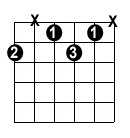Yikes! The diminished chord has frightened guitar plays for years. What is this strange beast? How the heck do you play it? What is it used for? In this lesson, you’ll discover the answer to these questions and I’ll reveal to you why you should never skip the diminished chord.
The diminished chord is an interesting chord. It is called the leading note because the seventh note of any scale naturally leads back to the root note or tonic. The diminished chord has a flattened third and a flattened fifth.
Diminished 7th chords are interesting chords because each note in the diminished 7th chord is 3 semitones apart. Therefore B°7 would be B D F Ab. What does this mean? Well, without going too deeply into the theory (why stop now I hear you say), technically every note in a diminished 7th can be the tonic because they are equal distances apart. This means that B°7=D°7=F°7=Ab°7. The same goes for Bb°7 and A°7, which have the notes Bb C# E G and A C Eb F# respectively.
So in reality, you only need to know three diminished 7th chords to play all 12!
A diminished 7th chord is comprised of a diminished triad ( is a triad consisting of two minor thirds above the root) plus a double flatted 7th (same note as the 6th). Its primary use is to lead to the tonic or root note of the song.
In most sheet music books, Cdim or C° denotes a diminished seventh chord with root C. Some modern jazz books and some music theory literature use Cdim or C° to denotes diminished chord, while Cdim7 or C°7 denotes a diminished seventh chord.
Here’s one of my favorite ways to play a diminished chord as it’s root is conveniently located on the 5th string:


| Fret | 1 | 2 | 3 | 4 | 5 | 6 | 7 | 8 | 9 | 10 | 11 | 12 |
| Chord | B° | C° | C#/Db° | D° | D#/Eb° | E° | F° | F#/Gb° | G° | G#/Ab° | A° | A#/Bb° |
Diminished chords are mainly used as a passing chord as it leads nicely back to I, however ending a song with vii°-I doesn’t sound as strong a V-I:
Which sounds stronger?
- B°, C
- G, C
Try the progression vii°7-I-V-I. This progression will help you to compare between the two:
- B°, C, G, C
vii°7 also works well moving into the vi chord. Try vii°7-vi-V-I:
- B°, Am, G, C
I personally like to sometimes use diminished chords to lead to a chord a half step higher. For example, try this progression:
- B°, C, C#°, Dm, F, G, C
Here are a few more ways to play a diminished 7th chord.


| Fret | 1 | 2 | 3 | 4 | 5 | 6 | 7 | 8 | 9 | 10 | 11 | 12 |
| Chord | C° | C#/Db° | D° | D#/Eb° | E° | F° | F#/Gb° | G° | G#/Ab° | A° | A#/Bb° | B° |


| Fret | 1 | 2 | 3 | 4 | 5 | 6 | 7 | 8 | 9 | 10 | 11 | 12 |
| Chord | B° | C° | C#/Db° | D° | D#/Eb° | E° | F° | F#/Gb° | G° | G#/Ab° | A° | A#/Bb° |


| Fret | 1 | 2 | 3 | 4 | 5 | 6 | 7 | 8 | 9 | 10 | 11 | 12 |
| Chord | F#/Gb° | G° | G#/Ab° | A° | A#/Bb° | B° | C° | C#/Db° | D° | D#/Eb° | E° | F° |